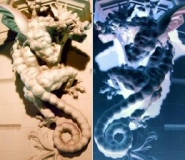Conveners
Parallel Session A. Supersymmetry and other searches-I
- André RUBBIA (ETH Zurich, Institute for Particle Physics)
Olaf Kittel
(University of Granada)
12/12/2008, 14:30
Supersymmetry
In the Minimal Supersymmetric Standard Model,
physical phases of complex parameters lead to CP violation.
We show how triple products of particle momenta or spins can be
used to construct asymmetries, that allow us to probe these CP phases.
We discuss the production of charginos and neutralinos at the
International Linear Collider (ILC). For the Large Hadron Collider (LHC),
we discuss CP...
Rainer Bartoldus
(Representative from the Babar collaboration)
12/12/2008, 14:55
Supersymmetry
We present recent results in quarkonium spectroscopy and searches
for new physics in bottomonium decays. Highlights include the
discovery of the bottomonium ground state in the reaction
Y(3S)->gamma eta_b. We present new limits on invisible and radiative
Upsilon decays which constrain models with light Higgs or light dark
matter candidates.
Andrea Ventura
(Università del Salento + INFN Lecce)
12/12/2008, 15:20
Supersymmetry
The search for Supersymmetry (SUSY) among the possible scenarios of New Physics is one of the most relevant goals of the ATLAS experiment running at CERN's Large Hadron Collider.
In the present work the expected prospects for discovering SUSY with the ATLAS detector are reviewed, and in particular for the first fb^-1 of collected integrated luminosity. All studies and results reported here...
Emma Torro Pastor
(IFIC CSIC - Universitat de Valencia)
12/12/2008, 15:40
Experimental Prospects
In certain supersymmetry breaking scenarios, characteristic signatures can be expected which would not necessarily be found in generic SUSY searches for events containing high-pT multi-jets and large missing transverse energy. In this talk, I will present the expected response of the ATLAS detector to signatures involving high-pT photons which may or may not appear to point back to the primary...
Takashi Shimomura
(University of Valencia)
12/12/2008, 16:00
Supersymmetry
When the mass difference between the lightest slepton, the NLSP, and the lightest neutralino, the LSP, is smaller
than the tau mass, the lifetime of the lightest slepton increases in many orders of magnitude with respect to typical
lifetimes of other supersymmetric particles. These small mass differences are possible in the MSSM and, for instance,
they correspond to the coannihilation...
Dr
Satoru Kaneko
(IFIC, Valencia Univ.)
12/12/2008, 16:20
Supersymmetry
We study the supersymmetric version of the type-II seesaw mechanism
assuming minimal supergravity boundary conditions. We calculate branching ratios for lepton flavour violating (LFV) scalar tau decays, potentially observable at the LHC, as well as LFV decays at low energy, such as $l_i ¥to l_j +¥gamma$ and compare their sensitivity to the unknown seesaw parameters. In the minimal case of...
Prof.
Myriam Mondragon
(Instituto de Fisica, UNAM)
12/12/2008, 16:40
Supersymmetry
We study Finite Unified Theories (FUTs) in the context of low-energy
phenomenology observables. The realistic FUTs we have studied all need
or imply discrete symmetries to be all-loop finite. We present a detailed scanning of
all-loop finite SU(5) FUTs, where we include the theoretical uncertainties at the unification scale and then apply several phenomenological constraints. Taking into...
